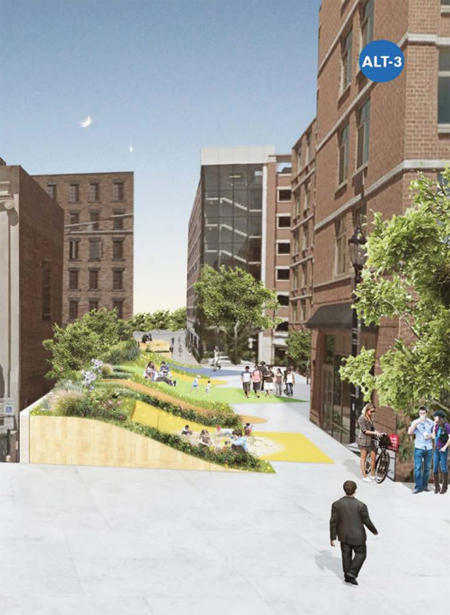A Progress Report from the Cutting Edge of Resilient Design

“We don’t know what resilience policy will look like in the new administration. There are lots of unknowns, but we can take solace in what we do know,” said Amy Chester, director of Rebuild by Design, at an event in Washington, D.C. that provided updates on how the six teams devising novel resilient designs in the tri-state area are doing two years into planning and design.
Rebuild by Design, a unique cross-sector initiative supported by the U.S. Department of Housing and Urban Development (HUD), Rockefeller Foundation’s 100 Resilient Cities Initiative, and numerous non-profit organizations, was created by President Obama in the wake of Hurricane Sandy, which hit the east coast in 2012 and damaged or destroyed 650,000 homes across 13 states. 148 teams submitted proposals to create new layers of defenses that could also be beautiful public amenities. 6 teams went onto receive nearly $1 billion in public financing.
Each team provided a brief update:
Bridgeport, Connecticut (see image above): David Kooris, with the Connecticut state government, explained how his team received $10 million from Rebuild by Design to create a comprehensive plan to make the low-lying, vulnerable South End more resilient to flooding. The funds, which are much less than what they’ve asked for, gave them extra capacity to plan. From that effort, they learned transit-oriented development, combined with surge protection, green infrastructure, and micro-grids should be core of their approach. They have since received another $54 million from HUD’s national resilience competition. Those funds will be split between implementing the project and developing a “state-wide policy” that can guide other coastal Connecticut resilient projects.
Alan Plattus at Yale University, who is involved in the research side of the project, explained how their plan will link two Olmsted-designed parks, Seaside Park, which is already tasked with surge protection duties, and Beardsley Park, at the mouth of the water system. Plattus thinks Olmsted’s original vision was to connect them. Bridgeport will begin implementation in 2019. Learn more.
Hudson River and Meadowlands, New Jersey: Hoboken, the 4th most dense city in America, received $230 million to control flooding. Alexis Taylor, New Jersey state bureau of flood resilience, explained how a network of berms and gates will be created to protect the vast majority of the city during storms. All the infrastructure will be created in public right-of-ways: alleys, plazas, and parks. An undulating sea wall will be aligned towards the interior of the city, rather than the coast. Vital infrastructure is protected. A network of green infrastructure also helps reduce inland flooding.

Taylor said about “85 percent of the city will be on the dry side, but this benefits 100 percent of the population because Hoboken will no longer be an island cut-off when it floods. All evacuation routes will be dry. This plan strikes the right balance.” Learn more in this presentation. Alternative 3 was finally selected by New Jersey’s government after much community input. Balmori Associates are the landscape architects.
Separately, the Meadowlands project received $150 million, which is far less than the $850 million they requested for the 9 miles of flood protection measures needed. As a result, the team is created a set of modular flood protection systems on streets, a “kit of parts, pre-cast, that can be easily scaled or replicated, and enables prototyping.” Pretty smart. MIT CAU, ZUS, and URBANISTEN are the landscape architects and planners on the team. Learn more.

Staten Island, New York City: Alex Zablocki, New York governor’s office of storm recovery introduced Pippa Brashear, ASLA, SCAPE Landscape Architecture, and their project, Living Breakwaters, which will result in a “necklace of breakwaters” off the Staten Island coast that will attenuate the impact of storm surges, build back beaches, create habitat for millions of oysters and fish, and “reconnect people with the shoreline.” SCAPE modeled the shoreline with their engineering team and tested specially-designed concrete that will enable biogenic build-up. Working with the One Billion Oyster Project, they are collecting literally tons of shells from restaurants to reuse in their breakwater reefs and educating the public about their mission. Brashear said the citizens advisory group was critical to the process, as was going out into neighboring communities to “show progress,” and make public events fun, through the use of virtual reality headsets and games.

Final designs will be ready in 2018. They are now working on schematic designs and environmental assessments before partnering with the U.S. Army Corps of Engineers on implementation. Learn more.
Long Island, New York: Nassau County received some $125 million, less than the $1 billion they asked for, said Laura Manufo, New York governor’s office of storm recovery. A layered solution will focus on integrated stormwater management along a greenway corridor that follows the Mill River, and preventing flooding and storm surge impacts from the bay through “strategically deploying protective measures like constructed marshes and dikes, which in turn will improve water quality and the bay ecology.”

Given the team received far less funds than they hoped, they needed to re-scope, explained Michael Bomar with Tetra Tech. “We narrowed the focus to low and middle income neighborhoods. One thousand acres is more manageable.” But, still, the team is dealing with 45 separate municipal and other stakeholders. An extensive team includes landscape architects H+N+S. Learn more.
Manhattan, New York: The Big U, which received the lion’s share of the Rebuild by Design financing, with $355 million, is designed to numerous communities and billions of real estate along the tip of Manhattan. The Big U will create an integrated system of compartments that can be closed in storms. The first phase to be built will protect the Lower East side, ranging from Montgomery Street up to 23rd Street in Stuyvesant Town, explained Carrie Grassi, City of New York. Most of the infrastructure will overlay the 2.4-mile-long East River Park. New berms accessible via bridges and a series of gates will protect critical infrastructure and communities. Protective measures average 8-9-feet-tall but reach up to 16 feet in some places.

Travis Bunt with One Architecture, a member of the team led by BIG, which also includes Starr Whitehouse landscape architects and Mathews Nielsen landscape architects, said the preliminary design work is done, but now details must be refined. Construction is expected to begin in early 2019.
Hunt’s Point, South Bronx: Jessica Colon, City of New York, said Hunt’s Point has suffered from years of disinvestment and bad planning decisions. It’s a mile from Manhattan, but feels like a world away. Hunt’s Point has a major market, which is one of the key food distribution hubs in the tri-state area, an industrial area, and a smaller residential area. The South Bronx team asked for $800 million but only received $20 million, so they decided to invest that in more planning. Through that process, the community decided to focus on coastal and energy resilience. They have received another $125 million to prototype projects. One realization that came out of their research: critical facilities are not the biggest worry; the “problems are more at the building level.”

Colon said the South Bronx is now at the “vanguard of adaptation. They’ve been ignored by the government for so long. They’ve been to hell and back. They can survive.” Design and construction on prototype projects begins in 2018. OLIN and PennDesign are the planners and landscape architects. After hearing from the teams, Jessica Grannis at the Georgetown Climate Center shared findings from her research into how “public officials overcame challenges to make these projects happen.” She offered a summary of key take-aways, which included:
- Create a long-term vision to drive policy and regulatory change. Create regional coordinators, as many issues cross jurisdictional boundaries.
- Design berms with benefits. Coastal defenses can offer multiple social and environmental benefits.
- Coordinate the layers of authority involved in nature-based coastal resilience projects. In inter-tidal areas, the federal government, state, and local governments will all have a say. Involve regulators early on in a coordinated way.
- Leverage public right-of-ways to avoid permitting and ownership issues.
For Grannis, if Rebuild by Design is successful, the projects will not only influence state and federal policy-making for public projects but also for private development.
And she thinks all of this work should have bipartisan support: “Resilience is more important than ever. If you are a Democrat or Republican, you want safe and prosperous communities.”
https://dirt.asla.org/2016/11/30/a-progress-report-from-the-rebuild-by-design-winners/


